|
28th July
Belhaven Bay and Dunbar Harbour
Isn’t
just like the thing, at the end of a week of record-breaking weather,
Sunday was predicted to be misty, wet and miserable. The least lousy
weather seemed to be in the east, so we headed for Dunbar. After a
brief pit stop to Dalkeith Morrisons (9.5/10: excellent stuff) we found
ourselves walking up the path towards Seafield Pond to the south of
Belhaven Bay. Along the edges of the path were many wild flowers. A
large patch of Germander Speedwell caught my eye, as did some Common
Fumitory ,
which is often called a garden weed, but which has some medicinal uses.
I asked John to use his binoculars to scan the treetops for a Greenfinch
I had heard. He quickly located it and, despite the gloom, I managed a
record shot. I noticed some Lesser Burdock was in bloom, a plant with
surprisingly many
uses such as its sliced root is used for stir-fry,
especially good with sesame seed and soy sauce.
| Common Field Speedwell |
Common Fumitory |
Greenfinch |
Lesser Burdock |
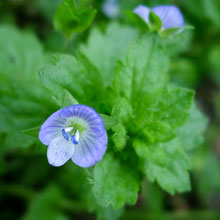 |
 |
 |
 |
We
next scanned the Bay for birds. There were many gulls, mainly
Black-headed, Herring and Lesser Black-backed. Many had juveniles
trailing behind them. There were no waders though.
| Lesser Black - backed Gull |
1st Cycle Lesser Black - backed Gull |
Herring Gull |
2nd Cycle Herring Gull |
 |
 |
 |
 |
Just
beyond the caravan site we turned into the attractive area where
Seafield Pond is situated. We stopped briefly at a rough verge where I
noticed lots of insects, mainly hoverflies, were on the flowers of
Creeping Thistle. Marmalade hoverflies and the Humming Syrphus were most
prominent (also see “Pictures of the Week”, below).
I also came across
a few tiny Flea Beetles, probably Altica
Lythri, .
These dark, blue-tinged beetles were a few millimetres long and
surprised me by jumping many times their own length as I attempted to
photograph them. Another beetle very much in evidence was the Soldier
Beetle. Every other flower played host to these large orange insects.
| Marmalade Hoverfly |
Hoverfly - Syrphus ribesii |
Flea Beetle |
Red Soldier Beetle |
 |
 |
 |
 |
We found even more
beetles crawling in and around the Common Ragwort flowers, the
millimetre long Pollen Beetles, Meligethes
aeneus.
One source describes how these have a great liking for yellow flowers.
We moved to the pond, where several Mallards were squabbling. The
drakes were in summer
plumage
and could easily be mistaken as females. At the edge of the pond I
noticed a nice Amphibious Bistort plant just managing to survive amid
surrounding vegetation.
Pollen Beetle -
Meligethes aeneus |
Female Mallard |
Drake Mallard in Eclipse plumage |
Amphibious Bistort |
 |
 |
 |
 |
We
were pleased to see a healthy number of butterflies were on show. We saw
the Green-veined White and Large White, but they were vastly
outnumbered by Painted Lady butterflies. Surely 2019 has seen the
biggest influx ever of Painted
Lady
butterflies. We also saw, but didn’t photograph, the Small
Tortoiseshell. While pursuing a butterfly I came upon a fly, probably a Tachanid fly,
Dexiosoma Caninum. These flies lay their eggs on other insects, but not
other flies. The larvae from these eggs then feed on the host insect,
weakening, and usually killing it.
| Green - veined White Butterfly |
Large White Butterfly |
Painted Lady Butterfly |
Flt - Dexiosoma caninum |
 |
 |
 |
 |
John
directed my attention to the middle of the back pool of Seafield Pond
where a Little Grebe was feeding its two chicks, making repeated dives
bringing up a small fish each time. On our way back we found a pair of
Common Inkcap mushrooms growing in the short grass. On the long grass
beside the path, a Smoky Wainscot moth clung onto a grass stem. Just
before we reached the car, I noticed the flower bug, Anthocoris Nemoralis crawling across a Ragwort flower. Also
crawling, or should it be “slithering”, was a Brown Slug
( taking its life into its hands by traversing the busy footpath (see
“Pictures of the Week”, below). Apparently a slug
has more teeth than a
shark.
| Little Grebe |
Common Inkcap |
Smokey Wainscot Moth |
Bug - Anthocoris nemoralis |
 |
 |
 |
 |
We relocated to Dunbar
Harbour, by the Battery,
and walked to the harbour mouth to view the Kittiwakes nesting on the
walls of the castle ruin. Most chicks were fledged or nearly fledged, but
a few looked young and vulnerable (see “Pictures of the
Week”, below).
It was a very active and noisy scene as birds were constantly coming
and going uttering their “kitt-i-wake” calls as the
went. A Cormorant
emerged from underwater and made its way into the harbour, no doubt
looking for scraps of fish occasionally thrown out by the fishing boats.
On the rocks to the north of the harbour most Herring Gull chicks
looked big enough to look after themselves but some were still
harassing their parents for food.
A view of the Dunbar
Harbour from the mouth:
Looking
over the harbour north wall we could see the Shag colony had depleted
as chicks had reached independence, but a few had still to get to that
stage. We spent a bit of time looking around the renovated Battery and
managed to observe a hovering Silver
Y Moth
as it fed off White Valerian flowers in the coastal garden there (see
“Pictures of the Week”, below). At the car a pair
of Sandwich Terns flew
low directly overhead making their distinctive creaking calls as the
went. Our last sighting was of some tiny Diamondback
Moths I found
resting on my car
windscreen. These are also called Cabbage Moths and since they feed on
cruciferous crops, they are considered by farmers to be pests.
| Shag |
Sandwich Tern |
Diamondback Moth |
 |
 |
 |
Well,
despite the dull weather we managed a wide and varied set of sightings,
well worth the reward of tea and apple lattice pastries. Hopefully
though we’ll get brighter weather next week as pictures do
look better
with more light.
Pictures of the Week:
11th July 2019:
Hogganfield Loch
As I was to be on
holiday on the 14th of July, I decided to base my weekly blog on a
midweek trip.
It was a bit of a
surprise when last Thursday afternoon turned out to
be sunny. Rain, with thunderstorms, had been
predicted. I
took advantage of the fine spell by doing a circuit of Hogganfield Park,
Glasgow to see what natural delights I could discover. John was
working, so I was on my own (or not, if you count the very many walkers
that use the park). On getting out my car (the car park is on the west
edge of Hogganfield Loch) I could hear the insistent, annoying and loud
cheeps of a Great Crested Grebe chick as it shadowed it’s
parent
across the Loch. The poor adult seemed demented with it and was trying
to “shake it off” by moving close to a few flapping
Greylags.
But its chick hung on. As I got a few shots of the pair I noticed a
small Pink-footed Goose feeding beside me on the grassy bank. It should
have been in Greenland. A Coot and its juvenile caught my attention as
I set off around the Park. It was helping itself to large helpings of
Pond weed, under the watchful eye of its nervous parent.
| Great Crested Grebe |
Greylag Goose |
Pink - footed Goose |
Coot |
 |
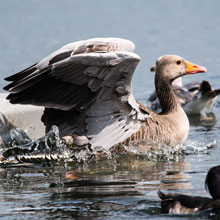 |
 |
 |
I noticed a drake
Mallard, its breeding plumage fading, replaced by its less attractive
summer feathers (this is known as “eclipse”
plumage). The Mallard female (see “Pictures of the
Week”,
below) looked much neater. Another duck entering the eclipse phase was
a solitary drake Pochard that was wandering rather aimlessly through
the crowds of birds. The edges of the Loch were bursting with beautiful
wild flowers. I noticed White
Deadnettle.
Its young leaves are edible and it is known elsewhere as the
“bee
nettle” because it is a rich source of nectar and pollen for
bees. Some tall, gorgeous Meadowsweet
dominated areas of the lochside. It has long been used in making
potpourri, wines and beer flavouring, antacid and clothing dyes.
| Mallard in Eclipse plumage |
Pochard in Eclipse plumage |
White Deadnettle |
Meadowsweet |
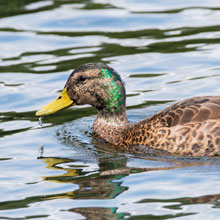 |
 |
 |
 |
As I explored the masses
of wild flowers by the Loch, Mute Swans passed
close, checking if I had anything for them (see
“Pictures
of the Week”, below).
Red Soldier Beetles
were having their fill on Yarrow flower heads. They look a bit scary,
and, due to their red colour, they are also known as
“Bloodsuckers”, although they are harmless. I also
saw tall
and pretty pink Great Willowherbs and, pushing through beside them,
much smaller, pink Common
Spotted Orchids .
Their name belies their elegant beauty. As I photographed the Orchid, a
Painted Lady butterfly swept in and landed conveniently ahead of me on
the grass. The tiny, delicate creature had flown from Mediterranean
Africa to be there.
| Red Soldier Beetle |
Great Willowherb |
Common Spotted Orchid |
Painted Lady Butterfly |
 |
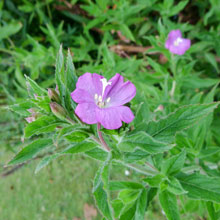 |
 |
 |
At the south end of the
Loch I found a large patch of Yellow
Rattle.
When its seeds develop they can be heard rattling inside their
container (calyxes) - hence the name. On the grass there were at least
a couple of species of Damselflies, the Common Blue and the Blue-tailed.
Damselflies are often confused with Dragonflies.
Damselflies have smaller eyes, long thin bodies and, when at rest, hold
their wings closed along their bodies. As I turned onto the east side
of the Loch, there were around ten Canada Geese resting on a pair of
the biohaven
islands
that are moored around the Loch. The biohavens were intended to provide
nesting platforms for endangered Great Crested Grebes. There were none
with the Geese.
| Yellow Rattle |
Blue - tailed Damselfly |
Common Blue Damselfly |
Canada Goose |
 |
 |
 |
 |
I decided to walk around
the pond that is in the rough and wilder area
to the east of the Loch. Fewer walkers use that route so it promised
some interesting sightings. On the water of a reedy ditch at the start
of the path to Avenue End Road I snapped a Pond Skater, a master of the
surface tension of water, enabling it to skim along the surface
catching smaller invertebrates. On the sides of the ditch there were
scrappy-looking, pink flowers of Ragged
Robin.
These used to be a common sight in fields but modern farming methods
have meant their numbers have fallen. Also by the ditch were
areas covered in yellow, orange and red flowers of Bird's foot
Trefoil,
so-named as each of their leaves forms a triplet that resemble a
bird’s foot (linkJ). At the south side of the pond I got a
pleasing shot of a Common Wasp on Bramble flowers (see
“Pictures
of the Week”, below). I heard Goldfinches twittering on the
north
side of the long hedgerow but they were very elusive. I did though get
a nice shot of Common Knapweed that was overlooking the pond.
| Pond Skater |
Ragged Robin |
Common Bird's- foot Trefoil |
Common Knapweed |
 |
 |
 |
 |
A Ringlet butterfly
surprised me by landing on some leaves by the
footpath. Normally they only touchdown briefly before moving on. Next I
left the Park and moved north along the old road, by Avenue Road, where
I passed a few Red Poppies. They were a very vivid scarlet, well worthy
of a photo. I re-entered the Park via the next entrance. A Gooseberry
bush still had many gooseberries hanging from its branches. The
branches close to the path were bare - evidence that walkers may have
been sampling them. The Sun shone through a tall flower head of Common
Hogweed, creating a fractal-like pattern.
| Ringlet Butterfly |
Red Poppy |
Gooseberry |
Common Hogweed |
 |
 |
 |
 |
A male Whitethroat moved
nervously between the branches of Bramble,
before settling on a shady spot on an adjacent tree. Just before the
path joined the main road around the Loch I came across a large patch
of Betony in a field of unmown grass. On the verges of the field a few
pink Perennial Cornflowers were in bloom. On one of them I spotted a
small brown insect. It turned out to be, on later research, a Plain-winged
Spring Beegrabber.
Apparently it frequents the same flowers as Bees, not just searching for
pollen and nectar, but to “grab” bees to lay eggs
in them.
Also in the field edges were a few blue
Cornflowers ,
another victim of modern agricultural methods.
| Whitethroat |
Betony |
Plain - winged Spring Beegrabber |
Cornflower |
 |
 |
 |
 |
On the last leg of my
circuit I got a nice photograph of a tall Purple
Loosestrife. On another biohaven platform I was pleased to see a nest
with a couple of Great Crested Grebes. They seemed to be sharing the
biohaven with Swans and various ducks. The Grebe looked very small
against the Swan. Let’s hope they are successful. I also
discovered a couple of pairs of Coots with young chicks. The tiny balls
of yellow, red and black fluff look very delicate. But many of them
should thrive (see also “Pictures of the Week”,
below). My
last shot of the trip was of a shabby drake Tufted Duck, probably in
eclipse.
| Purple Loosestrife |
Great Crested Grebe |
Coot Chicks |
Tufted Duck |
 |
 |
 |
 |
My lonely ramble around
a city park came up trumps as my sightings were
many and varied, and most of my photos were satisfactory. The
Beegrabber was a newbie for us, so I cannot grumble. It should be
business as usual next week.
Pictures of the Week:
| Mute Swan |
Female Mallard |
 |
 |
| Comon Wasp |
Coot |
 |
 |
7th July 2019: Doonfoot
The meteorological
report was clear, Ayr was going to be sunny and mild
on Sunday, while the rest of the Central Belt was in for more cloud. It
had been several
months since
we had visited Doonfoot at the south of Ayr. I thought an early summer
visit might yield some interesting sightings. We sped down the M77
(although we made a detour into Kilmarnock for a breakfast in Morrisons
(7/10: my breakfast was cold)) and arrived at the Doonfoot car park to
find the weather was indeed as the presenter had predicted.
We started by exploring
the pond area over the grassy bank north of the
car park. It was very quiet bird-wise but the vegetation was
burgeoning. I noticed a strange growth on a nettle stem, which, on
research I found was Nettle Clustercup
Rust fungus. A pair of Red
Soldier Beetles
were enjoying their time on a fine Yarrow flower head (in more ways than
one) (see, “Pictures of the Week“, below). As we
pushed
through the high grass lining the rough and narrow path I snapped an
attractive Dark-lipped Banded Snail that was attached to a nettle leaf.
But the most prominent plant at the pond was a six foot tall Giant
Hogweed. It’s a dangerous plant if touched, so I hope
Ayrshire
Council are aware of the risks, and remove it.
| Clustercup Rust |
Brown - lipped Snail |
Great Willowherb |
Giant Hogweed |
 |
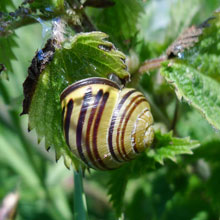 |
 |
 |
As we neared the River
Doon we came across some a pair of Valerians. The first was Red
Valerian , just
off the point of coming into bloom. The other was
Common Valerian ,
a much more elegant umbilifer and one that has interesting herbal uses.
At the river’s edge a little White Wagtail was enjoying a
tiny
bug it had just caught. Next we followed a Green-veined White butterfly
into the sand dunes where it came to rest on Sea Rocket
blooms.
| Red Valerian |
Common Valerian |
White Wagtail |
Green - veined White Butterfly |
 |
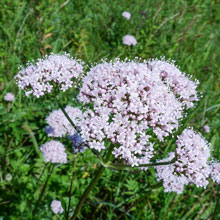 |
 |
 |
A large flock of House
Sparrows were very active on the seeding grasses
of the dunes. Their fledglings waited on the stalks of grass as their
parents nervously gathered seeds for them. I wandered out to the mouth
of the river where it flowed into the southern reaches of the Firth of
Clyde. Hundreds of birds, mainly Gulls and some Mute Swans, were
feeding. I noticed a pair of Greenshanks and a Redshank amongst them.
| House Sparrow |
House Sparrow Fledging |
Greenshank |
Redshank |
 |
 |
 |
 |
Back at the dunes I just
missed a picture of a male Linnet ,
resplendent in its red-breasted breeding plumage. The camera focused on
a single blade of grass leaving the bird image frustratingly blurred.
An Oystercatcher flew overhead as we retraced our way back past the
pond, but this time there was bird action there. A family of Goldfinches
were bathing at the water’s edge. Then a pair of Ringed
Plovers
swooped in, their high-pitched calls unsettling the finches. The Plovers
had a wee bath before they too were spooked by a passing dog.
| Oystercatcher |
Goldfinch |
Juvenile Goldfinch |
Ringed Plover |
 |
 |
 |
 |
In the middle of the
shallow pond, two Black-headed Gulls were behaving
quite oddly. Both were squawking their heads off as they paddled
side-by-side through the water. As we moved round the pond my attention
moved again to wildflowers. I caught a nice light on a flower of Meadow
Cranesbill. On a Red Clover flower a Buff-tailed Bumblebee was hard at
work. The flower heads of Wild Carrot were just developing. On one flower
head I spotted a scary-looking common parasitic wasp, Aritranis
Director (see,
“Pictures of the Week“, below).
| Black - headed Gull |
Meadow Cranesbill |
Buff - tailed Bumblebee |
Wild Carrot |
 |
 |
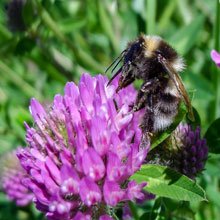 |
 |
As we passed the mainly
reed-covered south end of the Pond, we started
to hear the competing calls of a couple of Sedge Warblers. At first we
couldn’t locate them so we move further round the area. A
Painted
Lady butterfly landed obligingly on the path in front of me. Just after
I’d photographed it, a Sedge Warbler shot vertically in the
air
from an adjacent bush and descended onto a blade of Reed Mace (see
also, “Pictures of the Week“, below). Another
butterfly
turned up, a Meadow Brown feeding on a flower of Smooth Hawksbeard. We
returned to the car and drove the short distance south to the Greenan
Shore car park. Where we started our well-practiced circuit around the
castle ruin.
| Painted Lady Butterfly |
Sedge Warbler |
Meadow Brown Butterfly |
|
 |
 |
 |
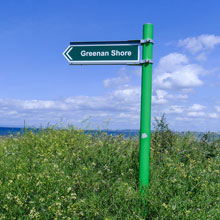 |
The first part of our
walk was very quiet. We saw little of special
interest along the shore, hampered no doubt by the high number of dogs
and their walkers. It wasn’t until we scaled the slope up to
the
ruin of Greenan Castle that we were much taken by the view to the south.
 |
We carefully negotiated
our way around the Barley fields to the east of
the castle and passed a 7-spot Ladybird lounging on a blade
of Barley. We passed a few bushes of Lesser Burdock on the edges of the
fields. Goldfinches made frequent appearances but didn’t settle
as
Sunday walkers disturbed them as they moved through the Castle grounds.
The House Sparrows were less flighty though. I photographed a demure wee
fledgling Juvenile Sparrow (see, “Pictures of the
Week“,
below). Twice we had Yellowhammers bursting unexpectedly out of the
hedges and over our heads. Nice to see but unfortunately no pictures.
We eventually descended onto a old tarred road off Greenan Road. On its
overgrown verge I found a thriving and very beautiful garden plant with
an exotic name, the Everlasting
Pea, lathyrus latifolius,
Rosa Perle . Our final sighting of the trip was a cracker. As
we moved from
the road back towards the dunes we heard the unmistakable, shrill call
of the Grasshopper
Warbler . We sat
on our stools for about half
an hour and watched the bushes for any signs of their movements.
Eventually we spotted one, and after a few photo-opportunities I had a
few record shots, unfortunately shooting into the sun. It was a pity
the lie of the land didn’t allow me to get on the other side
of
the bird, withe sun behind.
| 7 Spot Ladybird |
Lesser Burdock |
Everlasting Pea |
Grasshopper Warbler |
 |
 |
 |
 |
Well, the weather held
up. It actually felt like summer. Apart from a
couple of missed opportunities (the Linnet and Yellowhammer) we built
up a pleasing collection of sightings. So back at the car it was with a
fine sense of satisfaction that we downed tea with chocolate cream
eclairs. What a very pleasant pastime.
Pictures of the Week:
| Juvenile House Sparrow |
Grasshopper Warbler |
 |
 |
| Red Soldier Beetle |
Wasp - Aritranis director |
 |
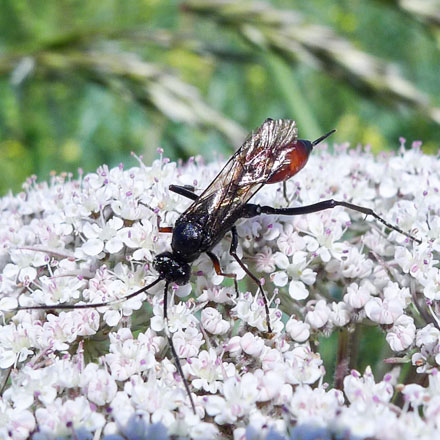 |
Back To Top
|

